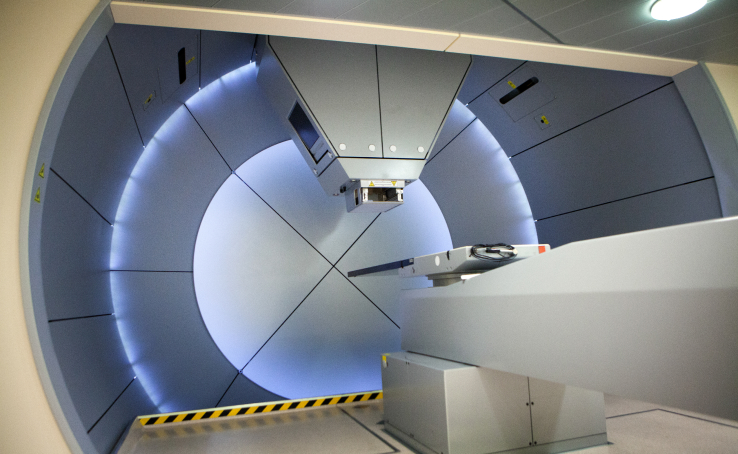Avg Price: $ 35000-$ 60000


Treatment Time
Recovery Time
Hospitalization Days
Success Rate
Proton Beam Therapy (PBT) has been on the rise across a range of cancer treatment types due to its remarkable physical attributes and superior dosimetric properties. In the twenty years following the inception of Proton Beam Therapy, multiple proton treatment centres sprouted around the globe. Up to this point in time, PBT has been employed in clinical contexts for roughly six decades, offering its advantages to ten thousands of patients with varying cancer types.
Despite being a developing country, India is rapidly evolving into a prime destination for cancer care. Specifically, Indian medical facilities have been advancing in the realm of cancer treatment, including the domain of Proton Therapy. Consequently, the process of locating the best doctor for proton beam therapy and the best hospital for proton beam therapy is becoming increasingly accessible and budget-friendly with each passing year.
Proton Beam Therapy, referred to as Proton Therapy, is a radiation-based treatment that accurately administers a stream of protons to interrupt and eliminate cancerous cells. Unlike conventional radiation, protons possess distinct attributes enabling medical professionals to more precisely direct radiation according to the tumour’s dimensions and contours. This proton beam eradicates tumour cells while safeguarding a larger portion of the neighbouring healthy tissue.
Proton Beams have the capacity to address tumours consisting of diverse cell types and situated in various regions of the body. Instances encompass:
Investigative research is still ongoing to explore the potential advantages of proton beam therapy for diverse Cancer types.
Take Charge of Your Health
Book a Free Consultation

Proton Beam Therapy represents the most recent advancement in radiation therapy, showcasing notable efficacy in healing, especially among young patients and children for Cancer treatment. The mechanism of action of Proton Beam Therapy involves interfering with the DNA of the tumour and eradicating its cells.
Over the recent years, the employment of PBT for patient treatment has been progressively rising on a global scale. This precise targeting capability of proton therapy provides several additional advantages:
Nevertheless, it should be noted that PBT comes with a higher price tag in comparison to the conventional X-ray therapy. Nonetheless, this increased expense could potentially be justified by the improved quality of life for patients and the reduction in costs tied to managing delayed adverse effects stemming from radiation treatment.
Proton beam therapy necessitates meticulous preparation to ensure accurate targeting of the proton beam and precise delivery of the intended radiation dose. Numerous distinct experts contribute to the planning and execution of proton therapy, such as radiation oncologists, nurses, dosimetrists, physicians, and radiation therapists.
The pre-evaluation process typically spans several weeks and encompasses the following steps:
Your Health is Our Priority
Book a Free Consultation
Proton Beam Therapy is an outpatient procedure conducted within a specialized facility. Most patients undergo treatment across multiple sessions, with varying durations. The proton therapy occurs within a dedicated room outfitted with a sizable mechanical arm, referred to as a gantry. This gantry is responsible for manoeuvring the proton beam around you while you remain positioned on a table. Throughout a proton therapy session:
The complications of Proton Therapy resemble those associated with conventional radiation therapy. These effects may manifest gradually after treatment and encompass:

After your treatment session is finished, you can resume your regular daily activities without emitting radiation or being radioactive. The complications of proton beam therapy (PBT) typically manifest gradually. Initially, you might encounter only minor side effects. However, as you undergo multiple treatments, you might start experiencing fatigue. This fatigue might give you the sensation that your usual activities require more energy or that you have reduced energy for your everyday tasks.
Additionally, you might observe skin redness similar to a sunburn in the specific area where the proton beams are targeted. Your doctor may advice you to restrain exposing yourself to direct sunlight and protect the treated area. Use sunblock, clothing, or other measures recommended by your medical team to prevent further skin irritation. Around four to six weeks after you finish your entire course of proton therapy sessions, you'll have your initial post-treatment meeting with your doctor. During this appointment, the doctor will conduct a physical examination, assess your advancements, go over any test outcomes, and address any inquiries you might have.
Avail the Expert Health Advice
Book a Free Consultation
Life after Proton Beam Therapy can vary depending on the individual, the type of cancer being treated, the overall health of the patient, and the specifics of the treatment. Proton Therapy had a comparatively lesser impact on individuals' capacity to carry out everyday tasks such as household chores when compared to conventional radiation. However, in few cases there can be delayed complications that may emerge months or even years after the completion of treatment. Depending on the treated region, delayed side effects might encompass:
The success rate of Proton Beam Therapy (PBT) can vary depending on several factors. However, the benefits of proton therapy for paediatric patients seems to minimize the probability of delayed negative effects and can also mitigate the risk of secondary cancers. This is supported by comparisons of the radiation dose distribution between PBT and photon radiotherapy, which demonstrate a reduced exposure of normal tissue to radiation in PBT. A recent study revealed that survivors of retinoblastoma (a kind of eye cancer) treated with PBT had notably lower 10-year cumulative rates of secondary tumours compared to those treated with photon therapy, both for tumours within the treated area (0% vs. 14%) and for all secondary malignancies (5% vs. 14%).
Proton Beam Therapy stands as a viable treatment option for older patients also dealing with lung cancer. A study indicates that the 3-year survival rate encompassed 67.2% (90.0% for patients with Lung Cancer amenable to surgery, and 58.2% for those with inoperable Lung Cancer) with PBT. Additionally, the 3-year rate of maintaining local control with PBT reached 86.5%.
The cost of Proton Beam Therapy in India is notably more budget-friendly when contrasted with rates in other nations. Furthermore, the medical care and services provided are on par with those furnished by some of the world's most renowned medical institutions. Even when accounting for accommodations, meals, and travel costs, the cost of proton beam therapy in India varies between approximately $33,000 and $65,000. In comparison, a series of radiosurgery treatments typically amounts to around $8,000 to $12,000, while intensity-modulated radiation therapy (IMRT) comes to about $15,000.
The cost of Proton Beam Therapy in India can fluctuate based on various factors, including:
The expenses associated with diagnosing proton beam therapy might encompass several preliminary assessments and examinations performed prior to the primary treatment. These supplementary costs cover diagnostic procedures like X-rays, CT (computed tomography) scans, MRI (magnetic resonance imaging) scans, PET (positron emission tomography) scan, biopsies, and other diagnostic evaluations. The overall costs for these tests can range from INR 50,000 to INR 10,00,000.
MedFlick, your trusted healthcare companion, is dedicated to ensuring that your medical journey goes as smoothly and successfully as possible.
Fostering expertise backed by commitment, resilience and years of experience, we connect you to a wide network of India's best doctors
Explore the most advanced, reputable and trusted hospitals in India, offering the highest levels of clinical and surgical excellence

The worlds most trusted personalized health community with more than 1,00, 000 members that share their journey, experiences and health insights. Join your community and get access to make informed health decisions.
Explore



